Download (5Mb) - Covenant University Repository
Download (5Mb) - Covenant University Repository
Download (5Mb) - Covenant University Repository
Create successful ePaper yourself
Turn your PDF publications into a flip-book with our unique Google optimized e-Paper software.
SENRA Academic Publishers, Burnaby, British Columbia<br />
Vol. 4, No. 2, pp. 1187-1197, June 2010<br />
ISSN: 1715-9997<br />
ESTIMATING GEOMAGNETICALLY INDUCED CURRENTS<br />
AT SUBAURORAL AND LOW LATITUDES TO ASSESS<br />
THEIR EFFECTS ON POWER SYSTEMS<br />
Falayi EO and Beloff, N.<br />
Space Science Centre, <strong>University</strong> of Sussex, Falmer, East Sussex, BN1 9QJ, UK<br />
ABSTRACT<br />
During large magnetic storm the geomagnetically induced current has a negative impact on ground conducting<br />
technology systems. The time derivative of the horizontal component of the geomagnetic field (dH/dt) is greater than<br />
30nT/min for induced currents causing undesirable consequence in power grids. Multiple regression analyses were<br />
developed to predict the level of geomagnetic disturbance using time derivatives of the horizontal geomagnetic field, east<br />
and north components of the geoelectric field, auroral electrojet and disturbance storm times from 1994-2007 at low and<br />
subauroral latitudes. The statistical test RMSE (Root Mean Square Error) and MBE (Mean Bias Error) were employed to<br />
evaluate the accuracy of the geomagnetic disturbance. Different variables have been used to develop different types of<br />
models. Values of the correlation coefficient and the coefficient of determination were high, which indicates that the<br />
results are good. The equations produced the best correlations at subauroral and low latitudes, and the best correlation<br />
was obtained with low values of RMSE and MBE.<br />
Keywords: Time derivatives of the geomagnetic field, geomagnetically induced current, latitudes.<br />
INTRODUCTION<br />
Grounds based technologies especially electric power, are<br />
susceptible to geomagnetic storms and geomagnetically<br />
induced current. This arises from the changes in the<br />
Earth’s magnetic field, caused by high energy particle<br />
streams from the Sun. It creates voltage between<br />
grounding points in the grid, which in turn induces a<br />
small, irregular dc current to flow along electric power<br />
lines and into transformers. Both space-borne and<br />
ground-based technology can experience problems due to<br />
space weather (Pirjola et al., 2005).<br />
Geomagnetically induced current (GIC) are directly<br />
related to the horizontal time derivatives of the<br />
geomagnetic field strength produced by the changing of<br />
electrical current in the ionosphere and magnetosphere.<br />
These changes in the geomagnetic field in turn produce an<br />
electrical current that flows around the Earth’s surface.<br />
Disturbances in power grid systems are directly related to<br />
geomagnetic storms and are caused by voltages induced at<br />
ground level by variations in ionospheric and<br />
magnetosphere currents. The magnetosphere and<br />
ionospheric electric current induces changes in the<br />
magnetic field and varying voltage in the crust of the<br />
Earth and this in turn drives a direct current through<br />
transformers, called (GIC). These GIC can harm power<br />
equipment and even cause a collapse of the power system<br />
(Coles et al., 1992; Makinen, 1993; Viljanen, 1998, 2001;<br />
*Corresponding author email: olukayodefalayi@yahoo.com<br />
Kappenman, 2006). Observations also confirmed that<br />
geomagnetic field disturbances usually associated with<br />
equatorial region current intensification can be a source of<br />
large magnitude and long duration GIC in power grids in<br />
low and equatorial regions (Erinmez et al., 2002).<br />
Kappenman (2005) established the fact that GIC studied<br />
during an October 2003 storm that caused geomagnetic<br />
disturbance in low and equatorial areas were due to ring<br />
current intensification that served as a source for GIC in<br />
the mid latitude regions.<br />
The fundamental principle of the flow of GIC in ground<br />
based technology is well understood using the Faraday<br />
law of induction. Electric fields drive current in ground<br />
technology networks. The geomagnetic variation and the<br />
geoelectric field observed at the Earth’s surfaces which<br />
primarily depend on the magnetosphere and ionospheric<br />
current, determine the space weather conditions in the<br />
Earth’s environment. Also, surface fields are affected by<br />
the current and charges induced in the Earth (Viljanen,<br />
1997; Trichtchenko and Boteler, 2006). The geomagnetic<br />
field variations are associated with geoelectric field<br />
variation at the surface of the Earth which is influenced<br />
by the conductivities of different structures of the Earth’s<br />
interior. The induced electric field is directly related to the<br />
rate of change of the geomagnetic field, which implies<br />
that many researchers have used time derivatives of the<br />
geomagnetic field as a measure of GIC strength. Boteler<br />
et al. (2000) concluded that geomagnetic disturbances are

















